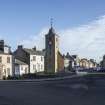Clackmannan, King Robert's Stone
Stone (Iron Age)(Possible)
Site Name Clackmannan, King Robert's Stone
Classification Stone (Iron Age)(Possible)
Alternative Name(s) Clackmannan Stone; Clack-mannan
Canmore ID 48321
Site Number NS99SW 6
NGR NS 91115 91889
Datum OSGB36 - NGR
Permalink http://canmore.org.uk/site/48321
- Council Clackmannan
- Parish Clackmannan
- Former Region Central
- Former District Clackmannan
- Former County Clackmannanshire
NS99SW 6 9111 9188
(NS 9111 9188) Stone (NR)
OS 25" map, (1970)
King Robert's Stone (NR)
OS 25" map, (1861)
King Robert's Stone was so called from a tradition connecting it with Robert the Bruce. Because of this association it was kept, first in Clackmannan Tower, and later at the Cross (Name Book 1861). The stone, called the Clackmannan Stone by Miller and Gordon, is, according to Gordon, traditionally said to have originally come from Lookabootye Brae (name: NS 9121 9125), probably from the foot of the brae. It is a whinstone boulder, 1 1/2" x 3 1/4" x 2 1/4". It has a deep cleft on its upper side, but there is nothing about it to indicate what it may have been originally (P Miller 1889). Early in the 19th century, a suitably shaped plinth was chosen from among the large boulders at the Abbey Craig at Causewayhead, and the stone, having been clamped together with iron bars, and a hole made in it for a flagstaff, was placed on top of it for better preservation. RCAHMS and Feachem create confusion by describing the plinth as the antiquity.
The Clackmannan Stone is regarded as that from which the county takes its name, which has been in use from the 13th century. Stone of Manau.
Name Book 1861; P Miller 1889; W J Watson 1926; RCAHMS 1933; T C Gordon 1936; R W Feachem 1963
A plaque on the adjacent Tolbooth states that the stone was originally placed at Lookaboutye Brae (NS 912 911) and was sacred to the pre-Christian deity Mannan, and is a relic of pagan times. It was raised on its shaft in 1833. No further information.
Visited by OS (D W R) 20 May 1974.
Field Visit (27 June 1928)
“Clack-Mannan."
This is an irregular, roughly tapering block of whinstone measuring 9 feet 4 inches in height and 15 feet in girth near the base, surmounted by a capstone, set in mortar, 1 ½ feet in thickness, 3 ¼ feet in length, and 2 ½ feet in breadth (SC 1167939). The large stone was placed beside the Tolbooth in 1833, and on it was set the small one, which had previously lain on the ground close by the old town cross "alongside of the old jail and courthouse" (1). The first part of the name appears to be the Old British or Welsh form clog and not the Gaelic cloch or clach, both words having the meaning "stone." "Mannan" or, more properly, Manann is the genitive case of Manau, the ancient name of the district round the upper reaches of the Firth of Forth, and appears also in Slamannan, a parish in south-east Stirlingshire (2). In some 12th-century charters, however, the name is "Clamanec" or "Clacmanet" (3).
RCAHMS 1933, visited 27 June 1928.
(1) Proc. Soc. Ant. Scot., xxiii (1888-9), p. 160. (2) Watson's Celtic Place-Names of Scotland, pp.55, 103. (3) Lawrie's Early Scottish Charters, Nos. clvi, clxxxviii.
Field Visit (August 1977)
'Clack-Mannan' NS 911 918 NS99SW 6
The name Clackmannan derives from the clach, or stone, of Manau, apparently a district of the tribe of Gododdin, the post-Roman descendants of the Votadini. The stone in question is a boulder (about 1m by 0.8m and 0.4m thick) which was placed in its present position outside Clackmannan Tolbooth, and on the top of a tall unworked stone brought from the Abbey Craig, near Cambuskenneth, in 1833.
RCAHMS 1978, visited August 1977
(Miller 1889, 159-64; Watson 1926, 103, 128; RCAHMS 1933, P. 320, No. 612; Gordon 1936, 6-8, 179; Feachem 1963, 74)
Publication Account (1985)
The Clach Mannan (from the Gaelic, Stone of the Manau) is a natural whinstone boulder which, in 1833, was placed on the top of an impressive monolith next to the Tolbooth in Clackmannan. For many years it had been kept in Clackmannan Tower (see no. 38) but it is reputed to have come originally from the foot of Lookaboutye Brae about 1km to the south (NS (912911).
As the name suggests, the stone is associated with the Manau, a local iron-age tribal group; its precise function, however, is unknown but it may have marked the site of the rallying point for the tribe or indicated a sacred place. The ritual use of a boulder, whether decorated (as are several of the Irish examples) or plain, was not uncommon in the Celtic world, but this practice should not be confused with the much earlier bronze-age tradition of erecting standing stones. Another well-known example can be seen at Lochmaben, Dumfries, where a large natural boulder, the Clockmabon stone, is associated with the worship of the Celtic god, Maponus. The Manau are also remembered in the placename, Slammanan, which lies on the south side of the Forth.
Information from ‘Exploring Scotland’s Heritage: The Clyde Estuary and Central Region’, (1985).
























